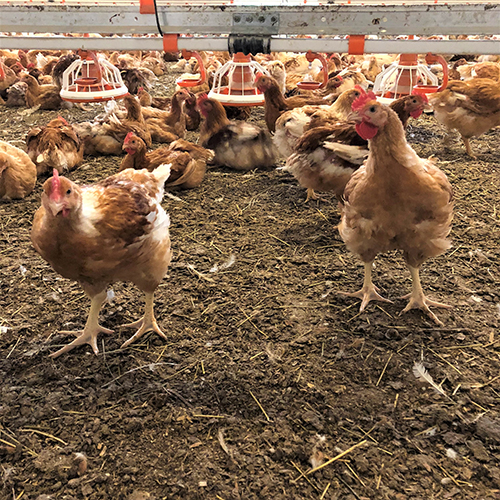How is the bird health at Swedish organic broiler farms?
A study of bird health and welfare in two slower-growing hybrids was performed in eight organic broiler chicken farms in Sweden in 2018. The bird health was in general good, but there are still needs for improvements.

When a slower-growing hybrid first became commercially available in Sweden during 2015, the national organic broiler chicken production increased considerably. There are currently two slower-growing hybrids, Rowan Ranger and Hubbard JA57/87. The organic broiler production is however still rather recent and the knowledge of animal health and welfare, production and farm management is limited.
Twelve organic broiler farms were, to our knowledge, present in Sweden in 2018. Eight of these farms were visited, in order to compile current experiences and knowledge of the present organic broiler chicken production. The farms were visited when chickens were between 44 and 62 days of age. Farmers were interviewed regarding management and husbandry routines, animal health and behaviour, productivity and free-ranging. Observations were made outdoors as well as indoors, including free-range use, housing environment, environment enrichment, bird behaviour and health.
On each farm a clinical examination of 50 birds was performed. An additional 25 birds were gait scored indoors, respectively outdoors if any chickens were observed free-ranging. Nearly half of the total number of chickens observed were scored as moderately dirty (47 percent), whereas the other half were without remarks (53 percent). Approximately one fifth (21 percent) of all chickens were observed with minor to moderate foot pad dermatitis, while the majority of the birds (79 percent) had no foot pad lesions. Furthermore, a proportion of birds (13 percent) had minor hock lesions. However, severe foot pad dermatitis or severe hock burn lesions were observed in none of the birds. No skin- toe- or comb damages were observed.
Chickens were gait scored both in- and outdoors, and scores were significantly better in the latter. The proportion of birds without remarks were more than twice as large among birds outdoors (54 percent) than indoors (23 percent). Furthermore, 71 percent of birds observed indoors, respectively 46 percent of birds observed outdoors, were found slightly or moderately lame (gait score 1 and 2).
The results provide new information and knowledge about bird health and welfare in slower-growing broiler hybrids in organic production in Sweden. Bird health was good in general, yet a proportion of birds was observed with dirty plumages, foot pad lesions and impaired walking ability, why there is still a need for improvement to ensure a better animal welfare.
Authors
Lina Göransson, Department of Animal Environment and Health, Swedish University of Agricultural Sciences (SLU) Skara, Sweden, lina.goransson@slu.se
Stefan Gunnarsson, Department of Animal Environment and Health, Swedish University of Agricultural Sciences (SLU) Skara, Sweden, stefan.gunnarsson@slu.se
Editor: Karin Ullven / Design: Christine Dilling
